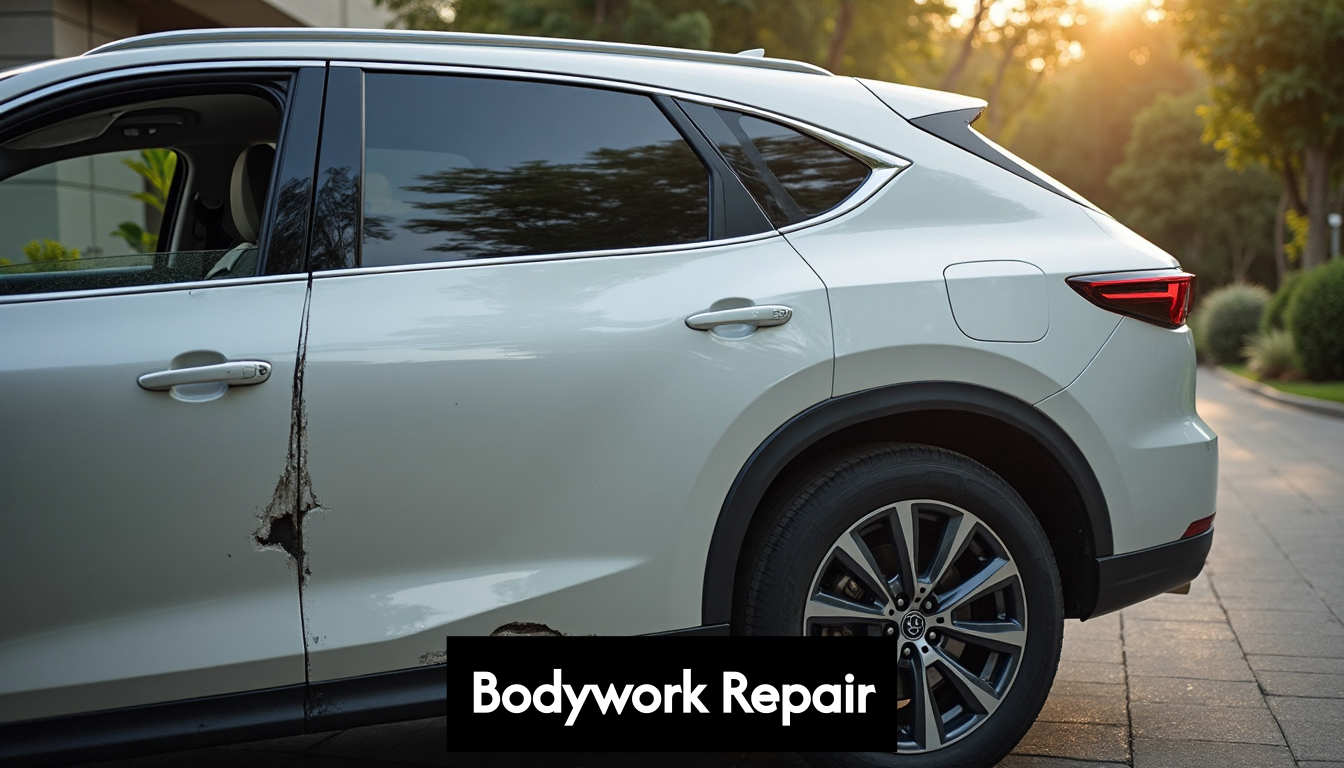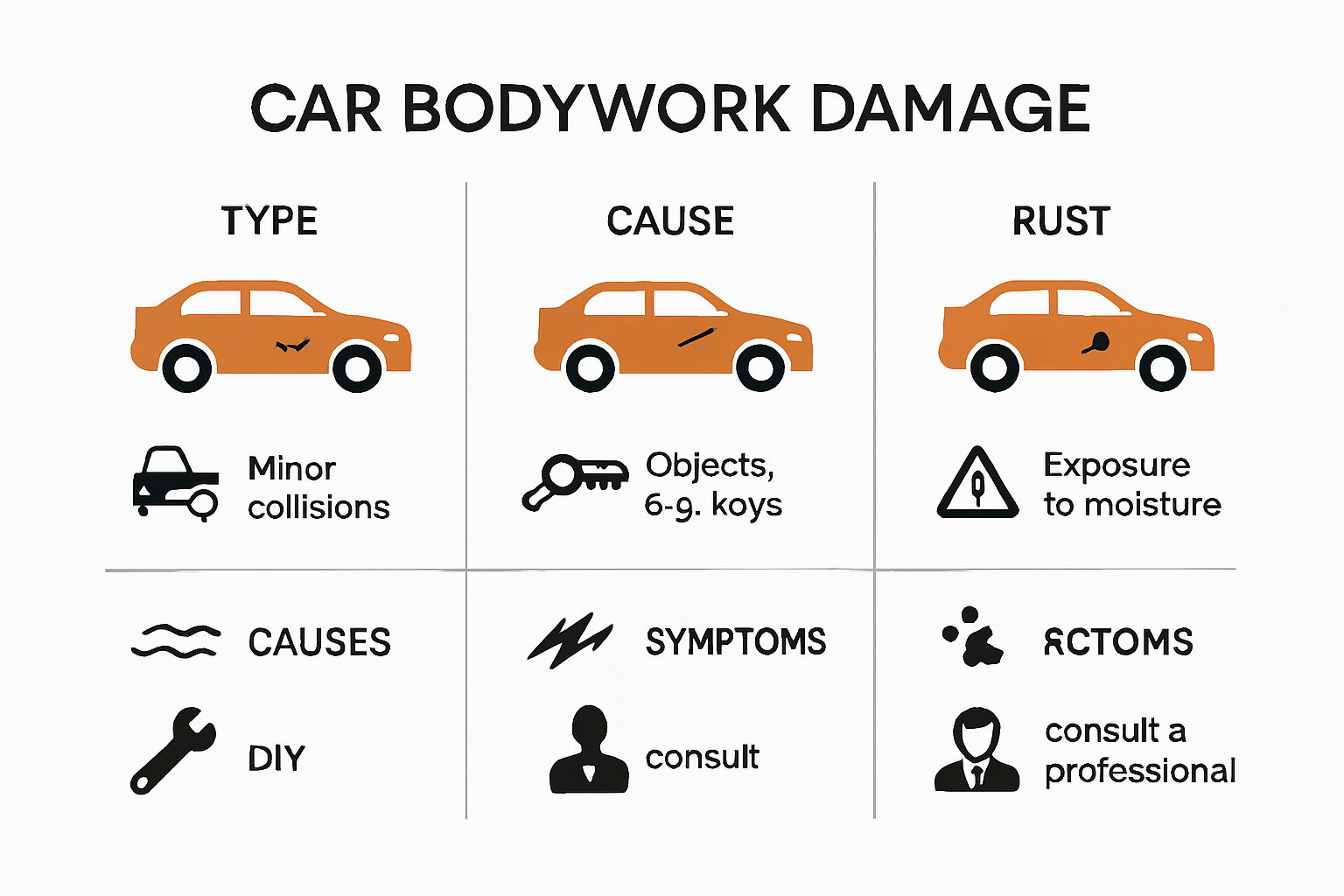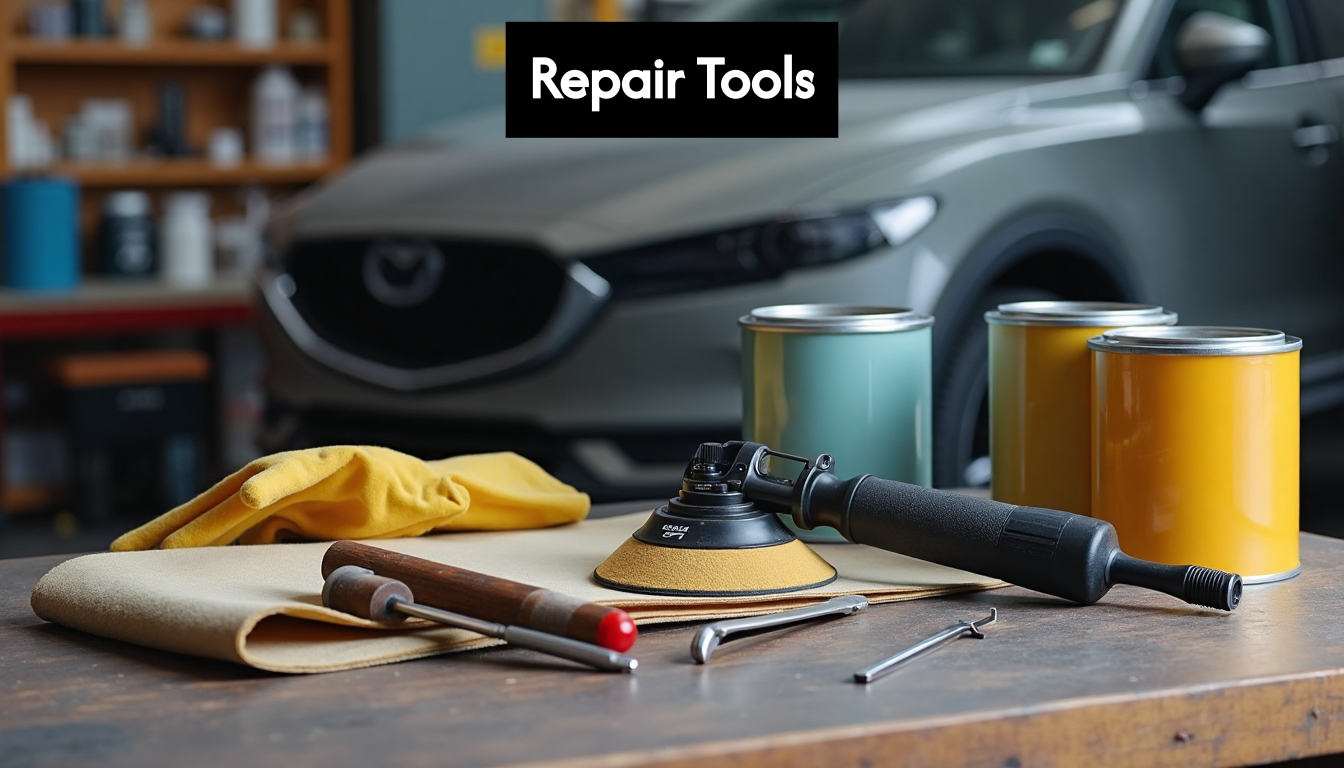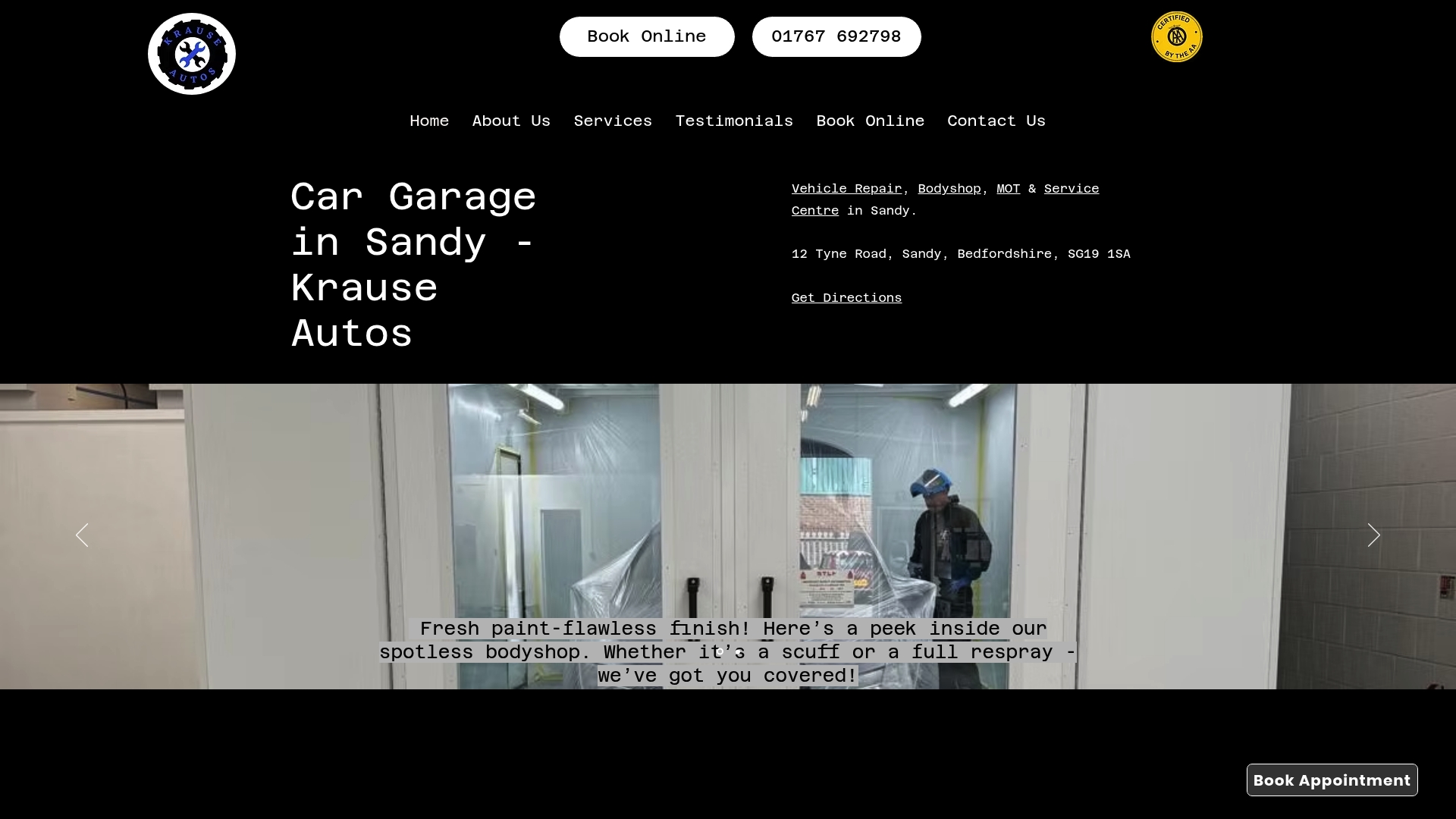2025 Car Bodywork Repair Tips for Everyday Drivers
- coledem
- Jun 17
- 8 min read
Updated: Jun 22
Car bodywork repair is more than just keeping your car looking sharp. Nearly half of UK car owners ignore minor scratches and dents, yet these small flaws can trigger costly corrosion and even compromise safety over time. Sounds trivial, but waiting too long can turn a simple fix into a serious problem. The real shock lies in how quickly unnoticed surface damage can spiral—often faster than most drivers think.
Table of Contents
Quick Summary
Identifying Common Car Bodywork Issues
Understanding car bodywork issues is crucial for maintaining your vehicle’s appearance, structural integrity, and long-term value. Modern drivers face numerous challenges when it comes to preserving their car’s external condition, with environmental factors, driving conditions, and everyday wear contributing to potential damage.
Surface-Level Damage: More Than Cosmetic Concerns
What might seem like a simple scratch or minor dent can quickly escalate into significant problems if left unaddressed. Surface damage often serves as an early warning system for potential underlying issues. Rust spots, paint chips, and minor abrasions are not just aesthetic concerns but potential indicators of more serious structural problems.
Drivers should pay close attention to:
- Paint Deterioration
: Small chips can expose bare metal, leading to rapid corrosion
- Scratches
: Deep scratches compromise protective paint layers
- Stone Chips
: These tiny impacts can create entry points for moisture and rust

For drivers seeking a comprehensive understanding of bodywork terminology, our detailed guide on car bodywork basics provides in-depth insights into identifying and managing these common issues.
Structural Damage Categories: Understanding Severity
Vehicle damage is not uniform and can be categorised to help drivers understand repair complexity. According to automotive damage classification standards, bodywork issues fall into specific categories that determine repair approaches:
Category N: Non-structural damage affecting vehicle functionality
Category S: Structural damage requiring significant repair
Category B: Extensive damage where only partial vehicle salvage is possible
These categories help drivers and mechanics assess the extent of bodywork damage and develop appropriate repair strategies. Understanding these classifications enables more informed decision making about vehicle maintenance and potential repair costs.
Environmental and Accidental Damage Factors
Car bodywork faces constant threats from various environmental and accidental sources. Road salt during winter, small stone impacts, parking lot dings, and UV radiation can progressively degrade your vehicle’s exterior. Urban driving environments with tight parking spaces and high traffic density increase the likelihood of minor collision damage.
Key prevention strategies include:
Regular protective waxing
Parking in covered areas
Using protective films
Prompt addressing of minor damage
By proactively identifying and addressing bodywork issues, drivers can prevent minor problems from developing into expensive repairs. Regular visual inspections, understanding damage categories, and seeking professional assessment when uncertainties arise are fundamental to maintaining your vehicle’s structural and aesthetic condition.
For more detailed insights into various types of body repairs, explore our comprehensive repair guide that breaks down different repair techniques and approaches.
Essential Tools and Products for Repairs
Successful car bodywork repair requires a strategic combination of professional-grade tools, quality products, and technical knowledge. For everyday drivers looking to manage minor repairs or understand the repair process, having the right equipment can make a significant difference in achieving effective and cost-efficient results.

Basic Repair Kit: Foundation for Bodywork Maintenance
A comprehensive basic repair kit should include several key tools that enable precise and careful bodywork restoration. Professional auto technicians recommend assembling a toolkit that balances versatility and specificity. Our guide to car bodywork terminology can help drivers understand the purpose of each tool.
Essential tools for your repair kit include:
- Sanding Tools
: Block sanders and various grit sandpapers for surface preparation
- Dent Removal Equipment
: Suction cup pullers for controlled dent extraction
- Application Tools
: Putty knives and spreaders for body filler application
- Protective Gear
: Safety glasses, dust masks, and work gloves
Investing in quality tools might seem expensive initially, but it prevents costly mistakes and provides long-term value in vehicle maintenance.
Specialist Repair Products: Quality Matters
Choosing the right repair products is as crucial as selecting appropriate tools. Body fillers, primers, paints, and protective coatings require careful selection based on specific repair needs. According to automotive repair experts, matching product quality to the repair complexity ensures better outcomes.
Key product considerations include:
Two-part epoxy body fillers for structural repairs
Rust-inhibiting primers
Colour-matched automotive paints
Clear coat sealants
Corrosion-resistant undercoatings
Drivers should always follow manufacturer instructions and consider professional consultation for complex repairs. Understanding product compatibility prevents potential damage and ensures optimal repair results.
Advanced Repair Techniques and Equipment
For more sophisticated bodywork repairs, specialised equipment becomes essential. A professional-grade hammer and dolly set allows precise metal shaping and dent removal, techniques that require significant skill and practice. While these advanced tools might seem intimidating, understanding their basic functionality can help drivers make informed decisions about repair approaches.

Advanced repair techniques include:
Paintless dent repair methods
Panel straightening
Precision metal reshaping
Comprehensive surface preparation
Our comprehensive repair guide offers deeper insights into these advanced techniques, helping drivers understand when professional intervention becomes necessary.
Remember that while DIY repairs can save money, complex bodywork issues often require professional assessment. Knowing your limitations and seeking expert advice prevents potential long-term vehicle damage and ensures safety and structural integrity.
Step-by-Step Minor Damage Fixes
Navigating minor bodywork damage requires a systematic approach that balances practical skills with careful technique. Modern automotive repair technologies have simplified many processes, enabling everyday drivers to address small imperfections effectively and economically.
Assessing and Preparing for Repair
Before beginning any repair, a comprehensive damage assessment is crucial. Our practical repair guide recommends a methodical approach to evaluating surface damage. Professional technicians suggest examining the affected area under good lighting, measuring the damage, and determining whether it requires professional intervention.
Key initial assessment steps include:
- Surface Examination
: Check depth and extent of scratches or dents
- Paint Condition
: Evaluate whether paint integrity is compromised
- Underlying Damage
: Look for potential structural issues
Repair Complexity
: Determine if the damage is suitable for DIY repair
Proper preparation involves cleaning the damaged area thoroughly, removing dirt and debris that could interfere with repair processes. Use automotive-specific cleaning solutions and microfibre cloths to prevent additional scratching.
Techniques for Minor Scratch and Dent Repair
Small Area Repair Technology (SMART) has revolutionized minor bodywork fixes. According to automotive repair experts, paintless dent removal (PDR) offers an efficient method for addressing small dents without compromising the original paint finish.
For shallow scratches:

Clean the area completely
Use fine-grit sandpaper to smooth the scratch edges
Apply automotive touch-up paint matching your vehicle’s colour
Use a clear coat to seal and protect the repaired area
For small dents, suction-based dent pullers can often restore the panel’s original shape. However, drivers should exercise caution and understand their technical limitations.
Safety and Professional Considerations
While many minor repairs can be managed independently, recognising when to seek professional help is critical. Complex damage or repairs involving structural panels require expert assessment. Advanced 3D scanning technologies now enable precise damage evaluation, helping drivers make informed decisions about repair approaches.
Warning signs that indicate professional intervention include:
Dents larger than a few centimetres
Paint damage exposing bare metal
Potential structural panel damage
Uncertainties about proper repair technique
Drivers should always prioritise safety and vehicle integrity over cost-saving attempts. Improper repairs can lead to more extensive damage and reduced vehicle value. Professional technicians possess specialised tools and expertise to address bodywork issues comprehensively.
Remember that preventative maintenance and careful driving remain the most effective strategies for minimising bodywork damage. Regular inspections, careful parking, and proactive care can significantly reduce the likelihood of requiring extensive repairs.
When to Call a Professional Versus DIY
Deciding between a do-it-yourself approach and professional bodywork repair requires careful consideration of damage complexity, technical skills, and potential long-term vehicle implications. Understanding the nuanced differences between DIY and professional repairs can save time, money, and prevent unintended damage to your vehicle.
Assessing Repair Complexity and Risk
Not all bodywork damage is created equal. Our comprehensive repair guide highlights the critical distinctions between manageable DIY repairs and those requiring professional intervention. Minor surface imperfections might be suitable for home repair, but complex damage demands specialised expertise.
Key factors determining repair approach include:

- Damage Depth
: Surface scratches versus deep panel damage
- Paint Condition
: Minor chips versus extensive paint deterioration
- Structural Integrity
: Cosmetic issues versus potential structural compromise
Technical Skill Level
: Personal mechanical experience and confidence
Professional technicians emphasise that modern vehicles, particularly electric and hybrid models, often require sophisticated diagnostic tools and specialised knowledge beyond typical DIY capabilities.
Financial and Technical Considerations
While DIY repairs might seem cost-effective initially, improper techniques can lead to more expensive long-term damage. According to automotive repair experts, professional repairs offer several critical advantages:
Precise colour matching using advanced technology
Guaranteed workmanship
Preservation of vehicle warranty
Advanced tools and techniques
Comprehensive damage assessment
The true cost of a repair extends beyond immediate expenses. Professional interventions often prevent future complications that could significantly increase overall repair expenditure.
Safety and Technical Limitations
Safety remains paramount when considering bodywork repairs. Modern vehicles incorporate complex materials and structural designs that require specialised knowledge. Attempting repairs without proper understanding can compromise vehicle safety and structural integrity.
Warning signs indicating professional intervention include:
Damage near critical structural points
Repairs involving advanced materials
Complex panel or frame damage
Uncertainty about proper repair technique
Potential impact on vehicle electronics
Professional technicians possess not just tools, but the nuanced expertise to diagnose and repair bodywork issues comprehensively. They understand the intricate relationship between seemingly cosmetic damage and potential underlying structural problems.
Remember that your vehicle represents a significant investment. While DIY skills are valuable, recognising personal technical limitations and seeking professional guidance demonstrates responsible vehicle ownership. Consulting with experienced automotive professionals can provide clarity, prevent costly mistakes, and ensure your vehicle remains safe and aesthetically pleasing.
Frequently Asked Questions
What are common car bodywork issues that drivers face?
Car bodywork issues include surface-level damage like scratches and dents, structural damage that affects vehicle safety, and environmental wear caused by factors such as UV rays and road debris.
How can I tell if my car damage requires professional repair or is suitable for DIY?
Assess the depth and extent of the damage. Minor scratches or small dents are often manageable for DIY repairs, while deep gouges or structural damage typically require professional intervention to ensure safety and proper repair.
What tools are essential for DIY car bodywork repairs?
A basic repair kit should include sanding tools, dent removal equipment, application tools, and protective gear. Investing in high-quality tools can significantly improve the repair process and outcomes.
Why is it important to address minor scratches and dents promptly?
Ignoring minor scratches and dents can lead to corrosion and severe structural problems over time, potentially compromising vehicle safety and increasing repair costs. Regular inspections and prompt repairs are crucial for maintaining your car’s condition.
Keep Bodywork Problems Small – Trust Krause Autos for Fast, Honest Repairs
Car bodywork issues can look minor but quickly lead to expensive headaches if ignored. The article explains how those small scratches, dents and chips can soon turn into rusted panels or hidden structural damage. It only takes a bit of neglect for paint to deteriorate or for underlying issues to go unnoticed. You deserve peace of mind without worrying that your vehicle’s safety or appearance will slip away.
Stop everyday damage from becoming a major problem. Bring your car to Krause Autos for dependable scratch and dent repairs in Sandy and Bedfordshire. We use the latest technology in our new bodywork centre, so you get honest assessments, skilled repairs, and local service you can trust. Book your visit today and give your car the care it deserves — let us restore your peace of mind and your vehicle’s value. Find out more about our complete car care solutions and bodywork expertise here.






Comments